There’s a new casual puzzle game that’s fun to play and free of ads, subscriptions, or hassle. It’s part of the growing suite of LinkedIn games and it’s called “Tango”. Here’s how to play – and win!
It used to be that if you wanted to enjoy a puzzle game on the Web, you were stuck with sites like Yahoo Games where you often couldn’t find the game for all the ads and junk on the page. Then Wordle came along and changed things, with big sites realizing that casual games can drive lots of traffic to their other content. Now the NY Times has a collection of excellent games (I particularly like Strands), the Washington Post has its own game suite (my fave: Keyword), and even LinkedIn has gotten in on the fun with its growing collection.
What’s nice about these is that they tend to be played on an otherwise blank page with no ads, no teaser headlines, no upsells, and, of course, no requirement for a paid subscription. For the most part, just append “/games/” to any of these site URLs and you’re ready to go. For example: linkedin.com/games/ takes you to the current set of games: Tango, Queens, Pinpoint, and Crossclimb. Each shows how many puzzles have been shown (one per day), so you can see that Queens, Pinpoint, and Crossclimb are part of the original set (each has 193 puzzles as I write this), while Tango’s the new kid on the block with only 33 puzzles.
I’m particularly a fan of Queens, but Tango has a very similar figure out placement given interlocking rules vibe to it. It’s fun, quick, and helps wake up your brain in the morning. Perfect for while you’re enjoying that first cup of coffee. Let’s check it out!
TANGO: THE BASICS
Before I show anything, I have to warn you that this article will be a spoiler for puzzle #33, Nov 9, 2024. If you want to give it a try yourself, just click thru to linkedin.com/games/tango/ and give it a shot.
When you go to that URL, here’s what you’ll see:

All of these casual online puzzle games keep track of both the time it takes for you to solve a puzzle and the number of days in a row you’ve solved it. This is undoubtedly inspired by social media where competing for posting streaks is a big deal in some younger circles…
A click on “Start game” and it will show you the grid:
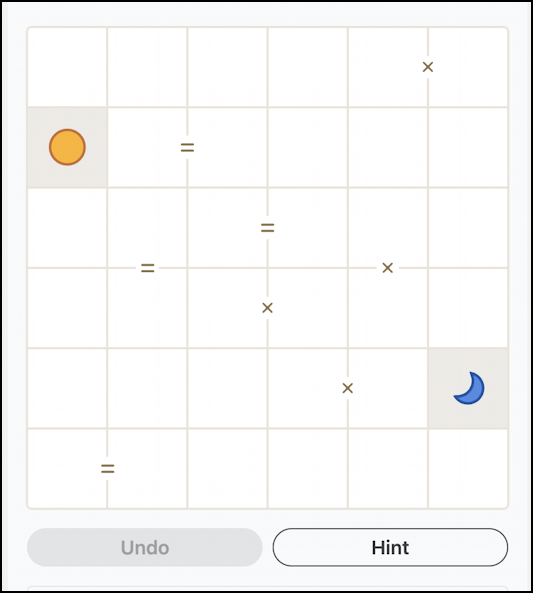
There are two symbols you’ll be placing on the 6×6 grid: Suns and Moons. Some edges have an “=” symbol while others have an “x” symbol. Two spaces connected by an “=” must contain the same symbol, and two connected by “x” must have opposite symbols.
There are two important placement rules:
- You can never have three of a symbol in a row horizontally or vertically, and
- Every row and column will balance out with three moons and three suns.
Remember, the tagline is harmonize the grid!
LinkedIn has some instructions you can view if you want a refresher, but if you remember the meaning of “=” and “x” along with the two rules I just mentioned, it’s rather redundant (and possibly confusing).
In terms of interaction, one click places a sun token, a second click turns it into a moon token, and a third click restores its empty state. Stuck? Click on “Hint” to get an indicator of how your solution compares to the correct answer.
TANGO: HOW TO FILL A SPOT
With that explained, every puzzle starts with a symbol or two already placed, and it’s smart to work off of those. For example, the sun symbol in the above grid has two adjacent spaces connected with an “=”. Since you can’t have three symbols in a row, those two adjacent spaces cannot also be suns. The game shows if you make an illegal placement:
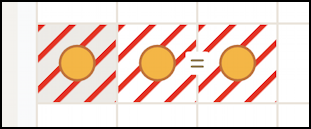
Not to worry, just click on a space to change the symbol therein. Are you thinking that these two have to be moons, not suns, given the no 3-in-a-row rule? You’re right.
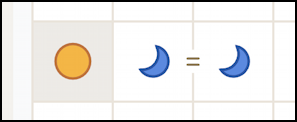
Sometimes an entire row or column will get the red marks, which can be a bit alarming, but, again, reverse your most recent placement and they’ll go away while you figure out where you might have gone wrong.
Looking at a slightly bigger portion of the grid, since we know that the moon = moon placement is correct (above) that means that the two symbols below the first moon must be suns:
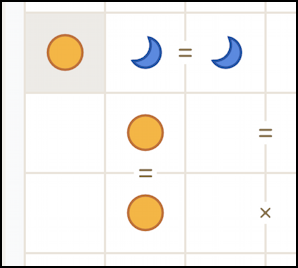
The “=” means they have to match and if they were moons we’d have 3-in-a-row, which is an illegal placement.
Now notice that just to the right of the sun in the second row are two spaces connected by an “=”. As we discussed earlier, they must be moons. This also means that the symbol adjacent to the lower sun (row 3) cannot be a moon (since we’d have 3-in-a-row vertically) so it must be another sun. Since it’s connected to its adjacent space by an “x” that means the next space over must be a moon!
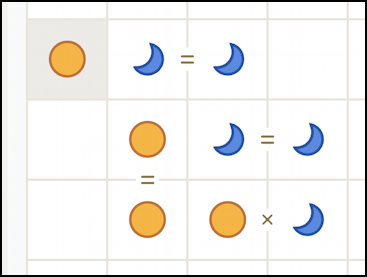
Now, given our rules, what’s the only symbol that can be in the fourth space on the top row? How about the first space on row three?
Continue down this path of logical inference about placement, also keeping in mind that every row and column must have three of each symbol and you’ll ultimately achieve the solution to the puzzle. For puzzle #33 – spoiler alert! – here’s the solved grid:
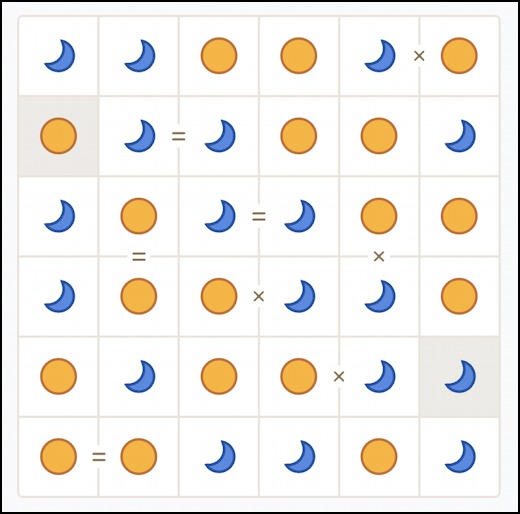
Pretty neat, right? Once you solve it you’ll get this splash screen:
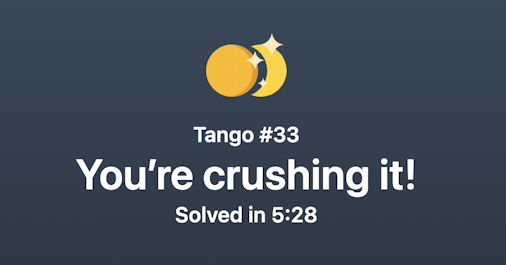
I’m just beginning to play this particular puzzle, as you can see, but I’m already liking it quite a bit. And if you like Tango, definitely try out Queens too!
Pro Tip: I’ve been a gamer and fan of casual puzzles forever and am always interested in learning about new games. I’m also a board game fan and review them over on my PlanetDave site too. Check it out: board game reviews. Thanks!
